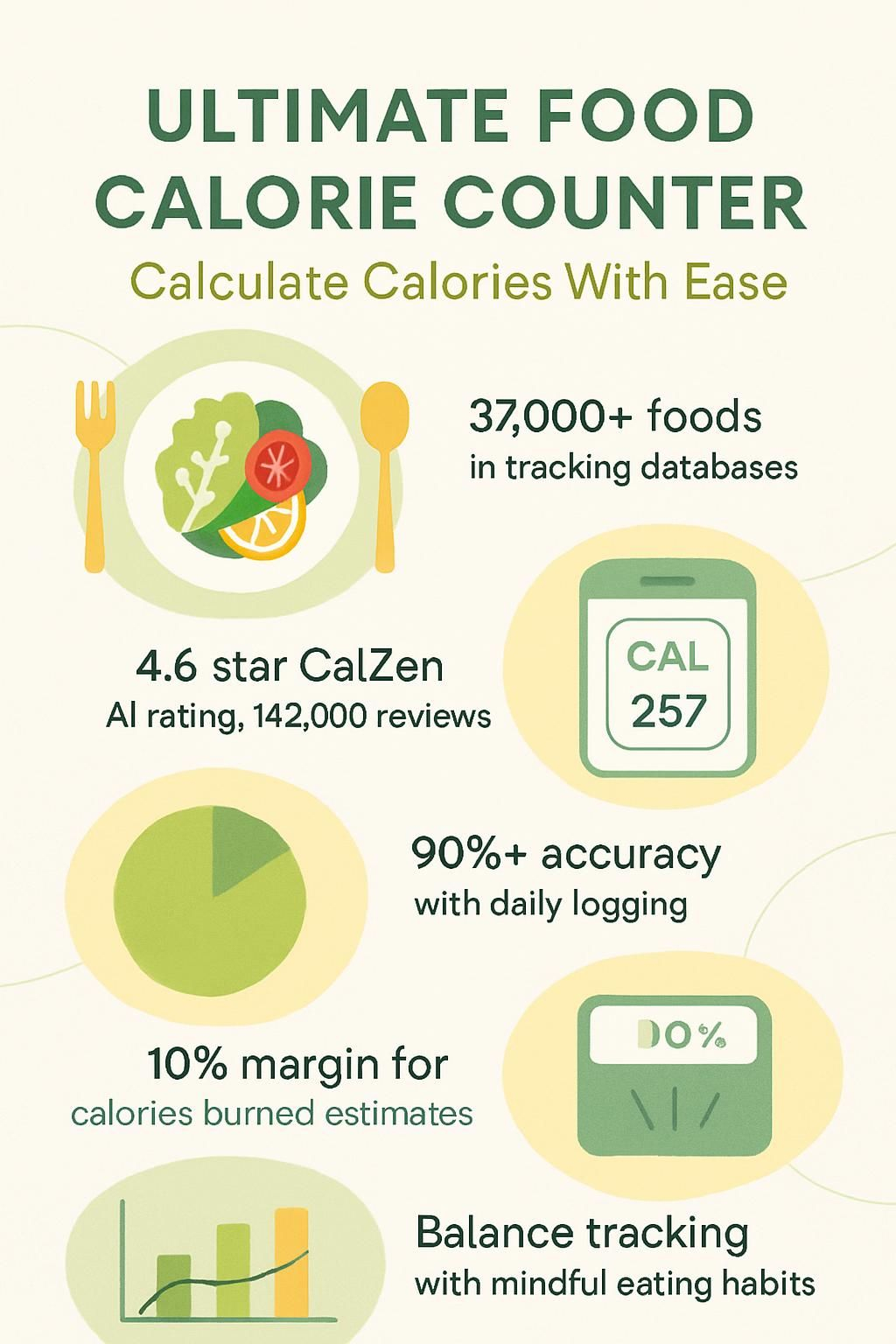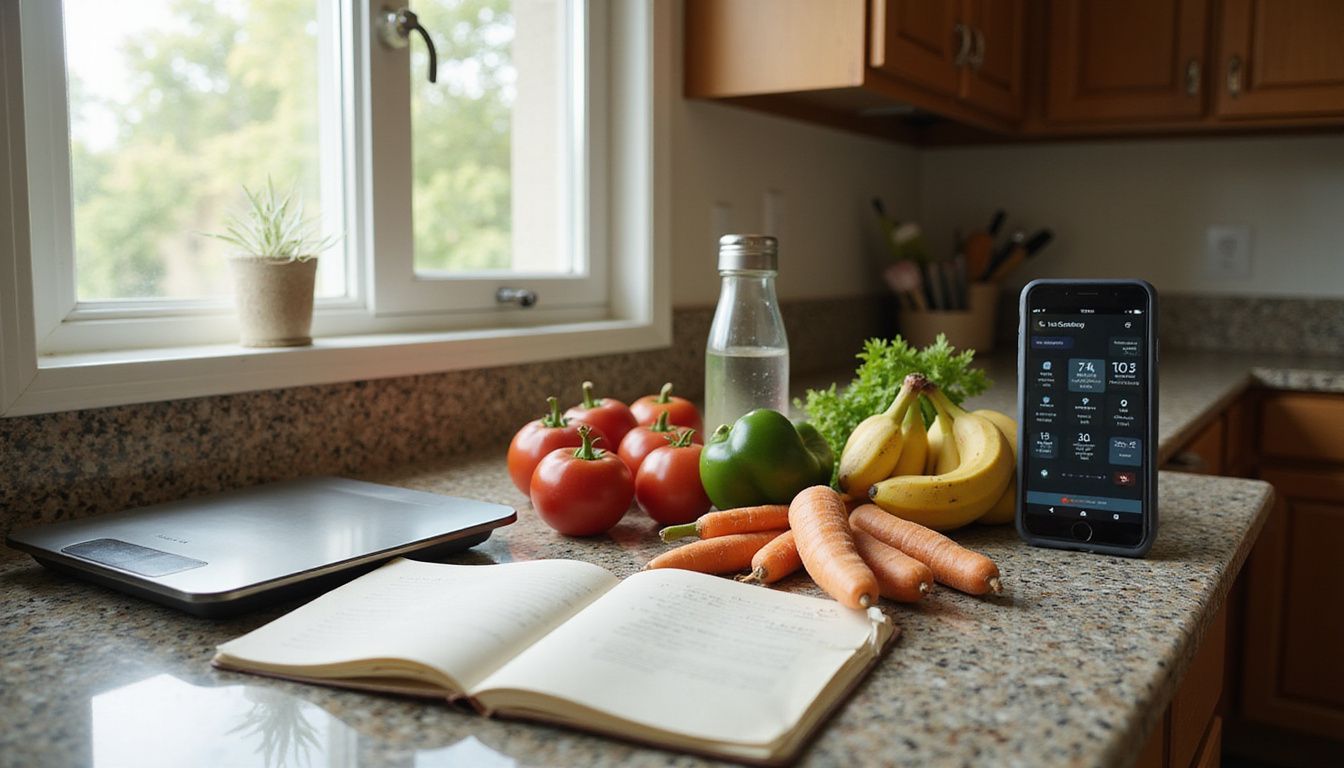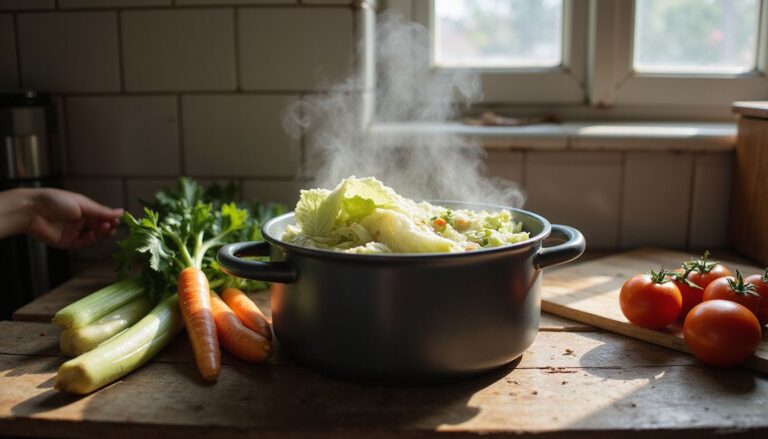Ultimate Food Calorie Counter: Calculate Calories With Ease
Our Nutrition Assistant AI Suite will transform your body. You will lose fat, get toned, and build muscle. Gain confidence and optimal health.
Counting calories can feel tricky, especially with busy days and mixed meals. A calorie counter or calorie tracker brings reliable nutrition data to your phone so you can see calories, protein, carbs, fat, and more in seconds. With a quality nutrition tracking app, you can track calories, check your macro targets, and use a built-in calorie calculator to guide daily choices.
This guide explains how a food calorie tracker works, how to set health goals, and how to get accurate numbers using a calculator or app. You will also learn how consistent logging supports weight loss and healthier eating, why tool choice matters, and how to balance tracking with mindful habits.
Key Takeaways
- Food calorie counters such as CalZen AI and MyFitnessPal use large food databases to track calories, carbs, protein, and fat with strong accuracy.
- CalZen AI, rated 4.6 stars from 142,000 reviews with over 1 million U.S. downloads, uses AI and barcode scanning for fast, real-time estimates.
- Consistent daily logging improves accuracy and reveals eating patterns and nutrition gaps that are easy to miss.
- Wearables like Fitbit sync activity data with food apps to estimate calories burned, with about 10 percent error for most users in a 2022 study.
- Relying only on tracking may increase food anxiety or miss bigger nutrition needs, so pair tracking with mindful eating for lasting habits.

What Is a Food Calorie Counter and How Does It Work?

A food calorie counter is a tool that tracks your daily food intake and shows the nutrition facts of each item. You can use a nutrition tracking app or calorie calculator to set targets and monitor progress for weight, energy, or performance goals.
What does a food calorie counter do?
A calorie counter lets you search and log foods from large databases that include restaurant dishes and packaged brands. Pick your meal or snack, and the app displays calories plus protein, carbohydrates, fat, fiber, and sugar per portion.
Many apps offer barcode scanning to add packaged items to your food journal in seconds. A calorie calculator then totals your day and compares it with your goals. For example, if your goal is 2,000 calories for weight control, the app warns you as you approach that limit.
Logging with a free calorie counter helped me notice hidden sugar in breakfast foods. Small swaps made weight goals more realistic without giving up taste.
How does a calorie counter function?
You enter foods using search or a barcode scan. Most health apps connect to trusted datasets like the USDA FoodData Central or the ESHA database. These sources store nutrition facts for many foods and recipes. After logging, the app shows calorie totals, macronutrients, and other details per serving.
Tracking tools often save your recent items so daily logging is quick. Many counters also let you set goals based on body mass index (BMI), height, age, basal metabolic rate (BMR), or target weight. Charts and simple dashboards help you track trends and meet macro goals for protein and carbohydrates.
A calorie counter works by turning what you eat into numbers that match your calorie needs.
Macro tracking can support low-carbohydrate and keto plans and shows how many calories come from each nutrient group. Wearables sync activity data from tools like Fitbit or Apple Watch, and estimate calories burned during exercise in real time. This combined approach keeps your daily balance clear, using current information from large food databases.
Benefits of Using a Food Calorie Counter
A food calorie counter helps you make better choices by displaying nutrition facts and tracking calories and macros in every meal. It also improves your understanding of your overall intake, which supports a healthy diet and steady progress.
How does a calorie counter simplify tracking?
With search and barcode scanning, you can log foods quickly. Many databases include fast food, restaurant meals, and recipes, which makes tracking both home and dining-out meals easier.
Clear summaries show daily calories, carbs, protein by gram, and macro breakdowns like fat and fiber. Using an all-in-one food tracker lets you see your progress without manual math. During my first week of intermittent fasting, seeing real numbers helped me stay under 1,800 calories and still enjoy favorite meals.
Meal planning features let you set calorie targets and prepare ahead, which saves time on busy days.
Can it help with weight management?
After seeing how tracking simplifies daily logging, the next question is weight control. Tracking food and calories highlights patterns that may lead to weight gain or stalled progress. Research in lifestyle medicine supports tracking as a helpful strategy for weight control for many people.
Apps allow you to analyze intake and set personal goals for daily calories and macros. A macro tracker like MyFitnessPal shows if you are in a calorie deficit for weight loss or a surplus for muscle gain.
“A food diary is like a mirror, it reflects exactly what fuels your body,” says registered dietitian Susan Brown. Many apps also offer meal plans that match your calorie target and goals.
What nutritional insights can it provide?
Calorie counters provide more than weight data. You can view calories, fat, carbs, protein, fiber, and sugar for every item you log. This information comes from reliable sources such as ESHA and the USDA.
Macro tracker tools let you set targets for protein, fats, or carbs. Meal planners and carb trackers act like a coach, helping you review your day and adjust. Scanning labels on grocery trips showed me some “easy foods” were loaded with sugar, which led to quick, smarter swaps.
How does it encourage healthier eating habits?
A calorie counter gives instant feedback on each meal. You can browse lighter recipes in the app and see nutrition breakdowns at a glance. Macro views help balance plates across carbs, fats, and proteins.
Guides that highlight better choices make swaps clear. Meal planning and fasting tools show how daily choices affect your targets. Over time, this steady feedback builds lasting habits instead of short-term fixes.
How can it help set and achieve health goals?
Use a calorie counter to set specific goals for calories and macronutrients. Log meals and compare your intake to targets, such as 500 calories per meal or a set macro ratio.
Meal planners let you schedule what to eat and when. A macro tracker reveals trends, like low protein across several days, so you can plan higher protein meals. Personalized feedback keeps you focused and motivated.
Types of Food Calorie Counters
You can track with mobile apps, online calculators, printed guides, and wearable devices. Each option supports different routines, and many people combine them.
What are mobile apps for calorie counting?
Mobile apps track your intake on a smartphone. You get access to large food databases, barcode scanning, quick logging, and easy summaries. CalZen AI, built by 42apps, shows carbs, protein, and fat, and supports weight loss through macro tracking. It holds a 4.6-star average from 142,000 reviews and over 1,000,000 U.S. downloads.
In my experience, using a tracker kept me aware of daily nutrition and led to steadier choices. With AI-powered analysis, you can set personal goals and sync with wearables for deeper insights. Apps reduce friction so tracking fits busy days.
How do online calorie calculators work?
Online calorie calculators let you enter foods and portions through a web page. You get instant totals for calories, carbs, protein, fat, and other nutrients. Many use USDA or ESHA datasets, and some act as macro trackers for deeper analysis.
With a few clicks, you see how a meal fits your daily plan. This makes it easier to compare options before you eat.
What are physical calorie books used for?
Physical calorie books list common foods with calories, protein, carbs, fat, and sometimes sugar and sodium. They help with portion control and offer an offline option if you do not want to use a phone.
Many people use these books for meal planning or grocery trips. On a camping week, I used one to plan meals and keep intake steady without screens. Books pair well with wearables or simple food journals.
How do wearable devices track calories?
Wearables such as Fitbit, Apple Watch, and Garmin estimate calorie burn using sensors that track movement, heart rate, and steps. These estimates combine with personal data like age, weight, and sex to model daily energy use.
Most calorie apps sync with wearables so you can compare calories in versus out on one dashboard. I use a fitness watch that syncs with my calorie counter, which makes it easy to adjust meals after active days. A 2022 study found many fitness wearables estimate calorie burn within about 10 percent for typical users.
Features of Modern Calorie Counter Tools
Today’s tools use AI, macro tracking, and smart databases to make accurate nutrition tracking simple.
How does AI improve calorie estimation?
AI sharpens estimates by analyzing images and product data in real time. Tools like the CalZen AI calorie deficit calculator can scan packaged items and estimate nutrition values on the spot.
Image recognition identifies foods and ingredients, even in mixed dishes. Your app can then break down protein, carbs, and fat with fewer manual errors. Machine learning matches items to likely serving sizes and refines suggestions as you log more meals.
What is barcode scanning and how does it help?
Barcode scanning lets you log packaged foods by pointing your camera at a code. CalZen AI includes a healthy food scanner that pulls official label data with one scan. This reduces manual typing and mistakes.
The scanner shows calories, macros, and ingredients within moments. You save time and gain better accuracy for your daily totals. During busy weeks, barcode scans kept my logging fast and consistent.
How to track macro and micronutrients?
After scanning, use a macro tracker to monitor protein, fat, and carbs and also follow micronutrients such as fiber and added sugar. CalZen AI includes a protein counter for strength or weight goals, plus daily nutrient tracking for quick checks.
Seeing the numbers in one place helped me adjust snacks for balance. Real data beats guesswork and keeps choices clear.
How do meal planning and recipe integration work?
Modern counters make planning simple. CalZen AI lets you build diet plans and add recipes directly to your calendar. Search recipes by calories or macro goals, then add ingredients with one tap.
The app calculates calories and macros per serving automatically. If you change the number of servings, portions adjust and totals update. This helps with family meals or batch prep. Built-in planners saved me from last-minute decisions and kept recipes aligned with my targets.
How do calorie counters integrate with fitness trackers?
Most counters sync with fitness trackers so you can view calories eaten and burned together. Apps like CalZen AI combine diet logs with macro data and training sessions on one screen.
If you manage diabetes or other conditions, this paired view helps you see how movement affects your daily nutrition plan. My fitness band links to my app, so I can compare yesterday’s workout with today’s meals in real time.
Popular Food Calorie Counter Apps
Several apps stand out for macro tracking, barcode scans, and strong databases. Explore options to find what fits your routine.
What features does MyFitnessPal offer?
MyFitnessPal offers a large food calculator with nutrition data for many common items. You can track calories, fat, carbohydrates, and protein with quick search and logging. Macro views show carbs and other macros for each meal.
The app uses reputable sources such as the ESHA database for accuracy. A handy search tool speeds up logging branded and restaurant items. You can also view privacy details on cookies and data settings. Resources like articles, podcasts, and community groups support learning and motivation.
How does CalorieKing assist in calorie counting?
CalorieKing provides a food calculator with nutrition information for many foods, including brands and restaurants. You can search by keywords to find items and add them to your Daily Totals for a clear daily snapshot.
Macro views show carbs, proteins, and fats per portion. The Diet and Weight Management section offers practical tips on meal patterns and portions. The site also provides privacy controls for safe browsing.
What is CalZen AI Tracker and how does it work?
CalZen AI Tracker uses advanced tech to streamline meal logging. Developed by 42apps, it has a 4.6-star rating from 142,000 reviews and over 1 million downloads. You can log meals with photos or short descriptions, and the AI estimates calories and macros quickly.
The food diary tracks calories, protein, fat, and carbs over time. The built-in nutrition scanner provides details for packaged items. Data is transferred using encryption, and users can request deletion. The latest update on October 10, 2025, improved support for current devices and databases.
What are the benefits of the Fitbit App?
The Fitbit App supports calorie counting and general wellness. It includes nutrition data for many foods and allows macro tracking for carbs, protein, and fat. The interface is simple, which makes daily logging easier.
Your data is stored with encryption, and updates often add features that users request. For many people, pairing Fitbit with a calorie counter gives a complete view of diet and activity.
How to Choose the Best Food Calorie Counter
The best tool fits your diet, schedule, and devices. A good match saves time and makes tracking feel natural.
How to consider your dietary needs when choosing?
Look for features that match your eating plan. Some apps support diabetes care, low-carb or keto plans, or food allergies. A macro tracker helps you see protein, carbs, and fat at a glance so each meal supports your goals.
Ingredient filters and custom recipes are useful if you avoid certain foods. On a low-carb plan, daily logging revealed hidden carbs in sauces that I would have missed. That insight improved consistency at each meal.
What makes an interface user-friendly?
A friendly interface keeps actions short and obvious. Apps like CalZen AI let you log with a photo or a short description, so there is less typing and guessing. Large buttons, readable fonts, and clear menus help you find macro and calorie data fast.
Designers test screens with real users so steps are simple and feedback is instant. People tend to stick with apps that take fewer taps for common tasks. Clear layouts and quick access to help reduce frustration.
How to check app compatibility with devices?
Confirm that the app runs well on your phone or tablet. Check the Apple App Store or Google Play listing for supported iOS or Android versions, storage needs, and recent updates.
If you use a fitness band or smartwatch, verify that the calorie app syncs with those devices. Reading user reviews often reveals any issues with syncing or support.
Why look for additional features like meal planning?
Meal planning tools help you avoid last-minute choices that break your plan. Look for diet planners, food journals, and recipe integration. A macro tracker shows grams of carbs, protein, and fat per meal so you can shape portions with confidence.
Research links structured planning with better weight control and diet quality. A 2017 study in the International Journal of Behavioral Nutrition found that meal planners were more likely to maintain a healthy body weight.
Common Challenges with Calorie Counters
Calorie databases are strong, but real-world meals vary. Overusing apps can also raise stress around food choices. Knowing the limits helps you use these tools wisely.
How accurate are calorie databases?
Most apps use reliable sources such as the USDA FoodData Central and ESHA. These databases rely on standardized testing and regular updates. Even with strong sources, actual calories can differ from labels due to cooking methods, brand differences, or crop variation.
If you track carefully, you will still get helpful insights. Expect small differences, especially with homemade meals.
What are the risks of over-reliance on tracking?
Depending too much on tracking can strain your mindset. Some people feel anxious when every bite must be logged. Others pay for a plan and focus only on macros, which may miss bigger nutrition needs like fiber, vitamins, and minerals.
You may ignore hunger and fullness if you rely on numbers alone. I started double-checking every meal and stressed when a restaurant dish was not in the database. Tracking is a tool, not a rulebook. Balance numbers with body cues for long-term health.
How to avoid misinterpreting nutritional information?
Apps often show macros like carbs, protein, and fat, but they may not explain fiber or sugar alcohols clearly. Always match serving sizes in the app with the package label. Small errors in portions can add up fast.
Use multiple sources when needed and review units, such as grams or ounces. Careful reading keeps you from missing key micronutrients while only watching calories.
Tips for Effective Calorie Counting
Smart habits make tracking easier and more accurate. These tips help you get clear insights without extra stress.
Why is consistency important in tracking?
Consistent logging creates accurate data. Track every meal, snack, and drink to see a clear picture. In my experience with CalZen AI, steady entries improved my estimates and revealed patterns like weekend snacks or low weekday protein.
Missing days creates blind spots and weakens your trends. Daily data makes decisions easier.
How to monitor portion sizes effectively?
Use a digital scale or measuring cups for a few days to train your eye. For a quick check, three ounces of chicken is about the size of a deck of cards. People tend to underestimate portions, which raises calorie intake.
Apps with AI, like CalZen AI, let you log with photos or short notes when you cannot measure. Compare your entries with USDA reference charts to improve accuracy over time.
How to focus on balanced nutrition?
Track your daily macro ranges. A common target is 45 to 65 percent of calories from carbs, 10 to 35 percent from protein, and 20 to 35 percent from fat, based on U.S. guidelines. An app breaks this down per meal and per day.
Choose nutrient-dense foods such as fruits, vegetables, whole grains, lean proteins, and healthy oils. Keep an eye on micronutrients like calcium, iron, and vitamin C along with calories.
How to avoid obsessive calorie counting?
Set short logging windows, for example five minutes after meals, instead of watching numbers all day. Use tools that simplify entries to keep stress low. Focus on trends and insights, not perfect numbers.
If tracking raises anxiety or guilt, step back. Review weekly summaries instead of each meal. Long-term habits matter more than any single day.
Role of Calorie Counters in Weight Management
Calorie counters help you see patterns and stay accountable. A macro tracker shows how your plate supports your plan, which makes steady progress more likely.
How do calorie counters support sustainable weight loss?
These tools let you measure intake with care and adjust in real time. Studies show that people who track consistently often lose more weight than those who do not track at all. You will notice meal times or foods that push you over your target.
Apps can update your daily calorie target as your weight changes. This keeps goals realistic and helps avoid plateaus.
How to monitor calorie deficits or surpluses?
Log every meal and snack into your app. Use the macro tracker to see carbs, proteins, and fats. Compare your total to your daily need. For example, if maintenance is 2,000 calories and you eat 1,700, you created a 300-calorie deficit.
Review weekly summaries to find patterns. Using an AI calorie deficit calculator helped me spot extra calories from drinks, which I had not noticed before.
How do they help maintain long-term health goals?
Daily logs create simple summaries that keep you honest. Macro views show where you fall short, like low protein at breakfast or high sugar at night. Adjust one meal at a time, and small changes add up.
Watching trends week by week keeps motivation strong and prevents small slips from growing into setbacks.
Advanced Innovations in Calorie Counting Technology
New tools use AI and smart cameras to improve speed and accuracy, which simplifies your daily routine.
What is AI image recognition for food items?
AI image recognition uses algorithms to identify foods from a photo. You take a picture, and the app detects items such as pasta, chicken, or broccoli. It estimates portion size and matches items with nutrition data.
CalZen AI uses this feature so you can log meals without typing. The macro tracker then displays carbs, protein, and fat automatically. Taking a quick photo made lunch tracking easy for me and felt more accurate than guessing. Research supports digital photography for more precise food intake estimates.1
…
^1: Martin CK et al., “Measuring food intake with digital photography,” J Hum Nutr Diet., 2012.
How do personalized dietary recommendations work?
Personalized recommendations use your age, weight, activity, and food preferences to shape your plan. CalZen AI includes a nutrition coach that analyzes your entries and macro balance in real time.
If you log a high-carb lunch, the app shows its effect on your daily totals and suggests how to balance dinner. While training for a race last spring, this feedback kept my macros steady without extra math.
What is real-time nutrient analysis?
Real-time analysis shows macro and micronutrient totals as soon as you log. You see protein, carbs, fat, vitamins, and minerals for each item within seconds. CalZen AI provides instant dashboards so you can adjust on the spot.
For example, scan a breakfast bar and get calories, macros, and key vitamins right away. Seeing my lunch stats early helped me plan an afternoon snack that fit my targets.
The Impact of Calorie Counting on Health and Lifestyle
Calorie counting raises awareness and brings structure to daily choices. Small insights lead to better meals and steadier energy.
How does calorie counting improve dietary awareness?
Tracking shows you what is in your food, not just the calories. A macro tracker highlights hidden sugars and fats that add up fast. Apps like MyFitnessPal can reveal when a drink carries more calories than a snack with fiber and protein.
Over time, you start choosing meals with better balance. Studies from 2022 suggest that routine trackers tend to pick meals with healthier macro patterns.
How does it help control eating habits?
Food logs make you pause and consider portions. Daily summaries reveal snacking patterns and late-night eating. Macro views show how each meal fits into the day.
When I started tracking, end-of-day summaries helped me cut extra soda and chips. Research from the National Institutes of Health links regular logging with higher odds of reaching a healthy weight.
How does it enhance understanding of nutritional needs?
A calorie counter breaks down meals into macros and key micronutrients. You can spot shortfalls, such as low fiber, or excess, such as too much sodium. Many apps include plain-language tips on vitamins, minerals, and fats.
I learned that my meals were low in iron and high in sodium. That data helped me plan dinners that aligned with guidance from groups like the American Heart Association, which suggests less than 2,300 mg of sodium per day for adults.
Common Myths about Calorie Counting
Misunderstandings about calorie counters can limit your progress. Clearing them up helps you use your tools with confidence.
Is it true that
Some people think tracking only calories is enough. In reality, macros matter too. A macro tracker shows how carbs, protein, and fat add up, which gives a fuller picture of your nutrition.
Another myth is that apps are always exact. Results can vary with cooking methods and portion estimates. Barcode scanning and AI image recognition improve accuracy, but you should still check serving sizes on labels. Use a calorie counter or calorie calculator as a guide, and pair data with common sense and body cues. For personal or medical concerns, consult a registered dietitian or your healthcare provider.
FAQs
1. How does a food calorie counter help analyze nutrition intake?
A food calorie counter uses data to track what you eat. It provides insights to help you analyze nutrition intake, showing how much energy and nutrients you get from each meal. This process supports better food choices and helps you meet health goals. Studies show that tracking food intake can improve diet quality and weight management (Harvard T.H. Chan School of Public Health).
2. What is a macro tracker and how does it show carbs?
A macro tracker is a tool that records the three main nutrients in food: carbohydrates, proteins, and fats. It lets you see carbs in each meal, helping you balance your diet. For example, if a breakfast contains 30 grams of carbohydrates, the macro tracker will display this value so you can adjust your intake as needed.
3. Can I use computer science concepts like Macro to improve calorie counting?
Yes, computer science concepts like Macro can automate repetitive tasks in calorie counting apps. This makes tracking faster and more accurate. Developers use these tools to build features that let users log foods and analyze nutrition intake with less effort.
4. What are the main benefits of using an ultimate food calorie counter?
The main benefits include accurate calorie tracking and detailed nutrition analysis. Users can monitor their macro intake and see carbs for every food item. This helps set and reach health goals with evidence-based data. In my experience using a calorie counter app, I found it easier to spot patterns in my eating habits and make healthier choices.
Summary: A food calorie counter gives clear insights into nutrition intake and helps track macros like carbs. Using computer science tools such as Macro improves accuracy and ease of use. These features support better health decisions and goal setting for users.







